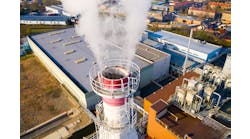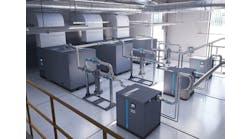Air compressors are key components in many manufacturing and process industries. They’re interesting from an engineering standpoint because of the many disciplines involved in their design and application. Also, they’re interesting historically because they are among the earliest machines, and most people have an intuitive understanding of compressor operation. Anyone who has used a bicycle pump or a bellows has operated an air compressor, and they know that work is required to compress air. Anyone knows that compression heats air.
Big Picture
The major compressor classes are positive displacement and dynamic. An example of the positive displacement class is the bicycle pump or fireplace bellows, both of which change the volume of a chamber to compress air. If a piston inside a cylinder forms the chamber, the compressor is known as a reciprocating type. These are further subdivided into single-acting and double-acting. In a single-acting type, only one piston face compresses the air; double-acting types use both faces alternately. Reciprocating compressor sizes range from fractional horsepower to more than 600 hp.
Another type is the rotary positive displacement compressor, in either helical screw or sliding vane varieties. The helical screw compresses air between a meshing rotating rotor and screw assembly. Helical screw compressors are available in sizes from about 3 hp to several thousand horsepower.
The sliding vane compressor uses a set of sliding vanes placed in slots on a rotor eccentrically mounted in a cylindrical casing. As the rotor spins, centrifugal force presses the vanes against the casing wall to compress air between the vanes and the casing.
To read the rest of this article from Plant Services, visit: http://www.plantservices.com/articles/2005/257.html

